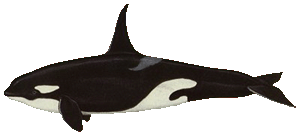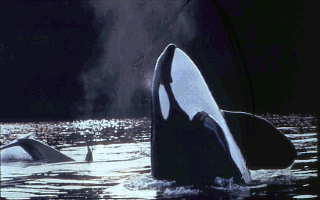
Killer whale

Scientific
Name: Orcinus orca
Other
Names: Grampus, Great Killer Whale
Length:
18-32.3 ft. (5.5-9.8 m.)
Weight:
2.6-9 tons
Teeth:
40-52
Killer
whales are the largest member of the dolphin family. These animals work
together herding and harassing their intended prey until it tires, then
they make their kill. Their prey includes sharks, seals, penguins, fish,
and whales. Their activities include lobtailing, breaching, flipper-slapping,
spy-hopping, beach-rubbing, speed-swimming, and dogging, however, they
rarely bow ride or wake ride.
There
are two distinct forms of Killer Whales, transients and residents. Transients
tend to form small pods, feed on mammals, vocalize less frequently, and
stay underwater longer. Resident pods are larger, have smaller home ranges,
feed on fish, and usually keep to predictable routes.

The killer whale(Orcinus orca) is the largest of the dolphins. The suborder is Globicephalidae from the order Odontoceti. First named in 1758. This whale is distinctive, with a beautifully streamlined body, characteristically marked with black and white. The black back and sides are clearly separated from the white belly. An extension of the white underparts passes up onto the side two-thirds of the way along the body. A white patch occurs just above and posterior to the eye. The dorsal fin is tall, up to 1.8 m. The flippers are large, almost rounded, and spade shaped. The flukes are of moderate size. Male killer whales may grow over 9 m in length and weigh over 8 tonnes. The females are somewhat smaller. The killer whale does not have a beak, merely its a demarcation of the lips. The dorsal profile of the body shows a perfect convex curve from lip to fluke, broken only by the dorsal fin. The mouth is very specialized. It has a very large gape and about 12 strong conical teeth. They are sharp and point backwards and inwards. The jaws close to form an efficient interlocking machine for gripping and tearing food. The first four cervical vertebrae are fused.
The killer whales are well known to the frequenters of Dolphinaria where humans often ride on their backs around the parkland pools. It is beautifull to see the whale jump out of the water. Man has had long associations with the terrible killer whale. Its bones have been discovered in prehistoric middens, and cave carvings thought to represent it, have been found in France. The Romans know this species from the writings of Pliny. It was indeed the Romans who first named it Orka, or 'sea devil'. Killer whales are widely distributed throughout the oceans of the world.
Killer
whales usually travel in small groups of from 6 to 50 individuals. These
groups consists of a mature male, sometimes more than one, females, adolescents
and young.
They may sometimes be single sex groups, but the significance of these
is unknown. They appear to hunt as an organized team. Observers have seen
them chase larger whales into an area of sea enclosed by land, place sentries
at the entrance to prevent escape, and then they attack, seemingly at a
given signal. Like other cetaceans, they are very dependent both on sound
waves and hearing for navigation, orientation and communication....